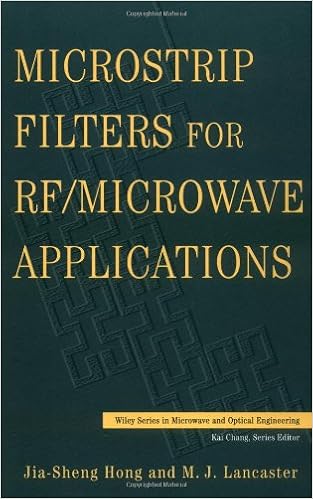
By Jia-Shen G. Hong, M. J. Lancaster
Microstrip Filters for RF/Microwave functions is the single specialist reference focusing exclusively on microstrip filters. It bargains a special and finished remedy of filters in line with the microstrip constitution and comprises complete layout methodologies which are additionally acceptable to waveguide and different transmission line filters.The authors comprise insurance of latest configurations with complicated filtering features, new layout concepts, and strategies for clear out miniaturization. The publication makes use of a variety of layout examples to demonstrate and emphasize desktop research and synthesis whereas additionally discussing the functions of commercially on hand software program. different highlights comprise: * Lowpass and bandpass filters * Highpass and bandstop filters * Full-wave electromagnetic simulation * complex fabrics and applied sciences * Coupled resonator circuits * Computer-aided layout for low-cost/high-volume construction * Compact filters and filter out miniaturization Microstrip Filters for RF/Microwave functions isn't just a necessary layout source for practitioners, but in addition a convenient reference for college kids and researchers in microwave engineering.
Read or Download Microstrip Filters for RF/Microwave Applications PDF
Similar microwaves books
MEMS-based circuits and systems for wireless communication
MEMS-based Circuits and structures for instant communique presents complete assurance of RF-MEMS expertise from equipment to procedure point. This edited quantity areas emphasis on how approach functionality for radio frequency purposes could be leveraged via Micro-Electro-Mechanical structures (MEMS). assurance additionally extends to cutting edge MEMS-aware radio architectures that push the potential for MEMS know-how extra forward.
Analog Circuit layout comprises the contribution of 18 tutorials of the seventeenth workshop on Advances in Analog Circuit layout. each one half discusses a particular to-date subject on new and useful layout principles within the quarter of analog circuit layout. every one half is gifted through six specialists in that box and state-of-the-art details is shared and overviewed.
Computational Nanotechnology Using Finite Difference Time Domain
The Finite distinction Time area (FDTD) technique is a vital device in modeling inhomogeneous, anisotropic, and dispersive media with random, multilayered, and periodic basic (or machine) nanostructures because of its positive factors of maximum flexibility and simple implementation. It has ended in many new discoveries relating guided modes in nanoplasmonic waveguides and maintains to draw cognizance from researchers around the globe.
Multi-dimensional Optical Storage
This e-book provides ideas and functions to extend the cupboard space from 2-D to three-D or even multi-D, together with grey scale, colour (light with diverse wavelength), polarization and coherence of sunshine. those actualize the advancements of density, ability and information move cost for optical facts garage.
- Optoelectronic Circuits in Nanometer CMOS Technology
- Broadband RF and Microwave Amplifiers
- Complex variables demystified
- Advances in Monolithic Microwave Integrated Circuits for Wireless Systems: Modeling and Design Technologies
Additional info for Microstrip Filters for RF/Microwave Applications
Sample text
It is the purpose of this chapter to describe various network concepts and provide equations that are useful for the analysis of filter networks. 1, where V1, V2 and I1, I2 are the voltage and current variables at the ports 1 and 2, respectively, Z01 and Z02 are the terminal impedances, and Es is the source or generator voltage. Note that the voltage and current variables are complex amplitudes when we consider sinusoidal quantities. 1 Two-port network showing network variables. where Re denotes “the real part of ” the expression that follows it.
12) This represents the true signal (baseband signal) delay, and is also referred to as the envelope delay. In network analysis or synthesis, it may be desirable to express the reflection parameter S11 in terms of the terminal impedance Z01 and the so-called input impedance Zin1 = V1/I1, which is the impedance looking into port 1 of the network. 4b). 15) Similarly, we can have where Zin2 = V2/I2 is the input impedance looking into port 2 of the network. 15) indicate the impedance matching of the network with respect to its terminal impedances.
For a lossless network, the Y parameters are all purely imaginary. 19) where In = 0 implies a perfect open-circuit at port n. 20) The matrix, which contains the Z parameters, is known as the open-circuit impedance or Z matrix and is denoted by [Z]. For reciprocal networks, Z12 = Z21. If networks are symmetrical, Z12 = Z21 and Z11 = Z22. For a lossless network, the Z parameters are all purely imaginary. 23) 2 where the matrix comprised of the ABCD parameters is called the ABCD matrix. Sometimes, it may also be referred to as the transfer or chain matrix.



